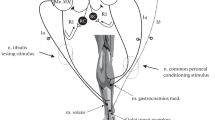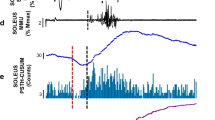Summary
With reference to the concept that contraction of a muscle can be inhibited by contraction of its antagonists, the excitability of a bifunctional muscle, the soleus (plantarflexor and adductor) was studied during voluntary isometric contractions of the abductors in man. For this purpose, the soleus monosynaptic stretch reflex (MSR) was solicited by means of quick-release dorsiflexion movements which also induce inactivation of the tibialis anterior (unloading reflex). When different initial torques of dorsiflexion were developed (reference conditions) the amplitude of the soleus MSR was found to be related linearly to the maximal value of angular acceleration. When an abduction torque was superimposed (combined efforts), the soleus response was always depressed, but no significant reinforcement of this inhibition was observed when the abduction torque increased. From present results, and from classical data concerning reciprocal inhibition between soleus and tibialis anterior, it is concluded that the MSR of a bifunctional muscle is depressed when the antagonists of either one of its functions are voluntarily activated.
Similar content being viewed by others
References
Angel RW, Eppler W, Iannone A (1965) Silent period produced by unloading of mucle during voluntary contraction. J Physiol (Lond) 180: 864–870
Araki T, Eccles JC, Ito M (1960) Correlation of the inhibitory post-synaptic potential of motoneurones with the latency and time course of inhibition of monosynaptic reflexes. J Physiol (Lond) 154: 354–377
Duchenne de Boulogne GB (1867) Physiologie des mouvements. Baillière et fils, Paris
Eccles JC (1963) Postsynaptic and presynaptic inhibitory actions in the spinal cord. In: Moruzzi G, Fessard A, Jasper HH (eds) Brain mechanisms. Eisevier, Amsterdam, pp 1–18
Garcia HA, Fisher MA, Gilai A (1979) H-relex analysis of segmental reflex excitability in flexor and extensor muscles. Neurology 29: 984–991
Gottlieb GL, Agarwal GC (1971) Effect of initial conditions on the Hoffmann reflex. J Neurol Neurosurg Psychiatry 34: 226–230
Gottlieb GL, Agarwal GC (1979) Response to sudden torques about ankle in man: Myotatic reflex. J Neurophysiol 42: 91–106
Hoffmann P (1918) über die Beziehungen der Sehnenreflexe zur willkürlichen Bewegung und zum Tonus. Z Biol 68: 351–370
Hoffmann P (1922) Untersuchungen über die Eigenreflexe (Sehnenreflexe) menschlicher Muskeln. Springer, Berlin
Hugon M (1973) Methodology of the Hoffmann reflex in man. In: Desmedt JE (ed) New developments in electromyography and clinical neurophysiology, vol 3. Karger, Basel, pp 277–293
Kapandji IA (1975) Physiologie articulaire. Maloine, Paris
Kearney RE (1978) Simulation of the human neuromuscular response to ankle rotation with a segmental reflex model. Comput Biol Med 8: 329–341
Morin C, Pierrot-Deseilligny E (1977) Role of Ia afferents in the soleus motoneurones inhibition during a tibialis anterior voluntary contraction in man. Exp Brain Res 27: 509–522
O'Connell AL (1958) Electromyographic study of certain leg muscles during movements of the free foot and during standing. Am J Phys Med 37: 289–301
Paillard J (1955) Réflexes et régulations d'origine proprioceptive chez l'homme. Thèse Doctorat d'Etat, Arnette, Paris
Perot C (1979) Approche biomécanique de la difonctionnalité musculaire. Thèse 3ème cycle, Compiègne
Perot C, Goubel F (1980) Control mechanism of bifunctional muscles: a reflex approach. In: Morecki A, Fidelus K (eds) Biomechanics VII. University Park Press, Baltimore, pp 82–86
Perot C, Goubel F (1981) Synergy between bifunctional muscles at the ankle joint. Eur J Appl Physiol (in press)
Pertuzon E, Lestienne F (1971) Influence des valeurs initiales de la position de l'articulation et de la force sur les modalités des réflexes évoqués par “quick-release”. J Physiol (Paris) 63: 264A-265A
Vallbo AB (1974) Human muscle spindle discharge during isometric voluntary contractions. Amplitude relation between spindle frequency and torque. Acta Physiol Scand 90: 319–336
Author information
Authors and Affiliations
Additional information
Supported in part by a DGRST grant (78.7.2347)
Rights and permissions
About this article
Cite this article
Pérot, C., Goubel, F. Effect of antagonistic contractions on the reflex response of a bifunctional muscle. Europ. J. Appl. Physiol. 48, 51–58 (1982). https://doi.org/10.1007/BF00421164
Accepted:
Issue Date:
DOI: https://doi.org/10.1007/BF00421164




